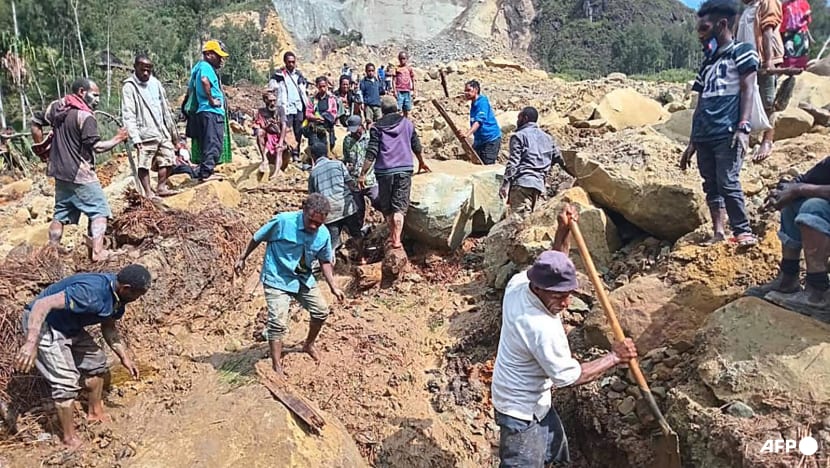Some 8,000 affected by Papua New Guinea landslide as unstable terrain hampers recovery efforts
Hopes of finding survivors under a shifting mass of rubble are fading, while thousands have been ordered to evacuate from the path of the still-active landslide.

People digging at the site of a landslide at Yambali Village in the region of Maip Mulitaka in Papua New Guinea's Enga province, May 26, 2024. (Photo: International Organization for Migration via AFP/Mohamud Omer)

This audio is generated by an AI tool.
Unstable terrain and risks of further landslides are hampering recovery efforts in Papua New Guinea, aid organisations said, as the number of those displaced by the disaster continue to climb.
CARE International on Tuesday (May 28) estimated that some 8,000 people have been affected by last Friday’s massive landslide, which crushed homes and food gardens in the South Pacific nation’s remote highlands.
“The impact is beyond anything I've seen in this part of the world,” the humanitarian agency’s country director Justine McMahon told CNA.
Hopes of finding survivors under a shifting mass of rubble are also fading. Thousands have been ordered to evacuate from the path of the still-active landslide.
“A lot of rocks (are still) falling from the mountain, pushing the debris further, causing an extremely dangerous situation for the surrounding villages,” said Mr Serhan Aktoprak, chief of mission in Papua New Guinea at the International Organization for Migration (IOM), a United Nations related agency.
“The conditions on the ground are very volatile. The debris is still moving, increasingly posing additional danger to relief teams,” he told CNA’s Asia Tonight from the country’s capital Port Moresby, where relief efforts are being coordinated.
Local authorities told the UN the initial landslide that swept through Yambali village in the country’s north in the wee hours of May 24 buried more than 2,000 people in their sleep.
Mr Aktoprak said victims are buried under 6 to 8m of thick soil and debris.
The landslide also blocked part of the province’s main highway, cutting off access to the village and communities beyond.
AID WORKERS FACE CHALLENGES
With relief efforts severely hampered by the remote location and heavy rainfall, locals have been digging through debris with their bare hands, sticks and small tools.
Mr Aktoprak said some grieving families also do not want powerful machinery and excavators to enter the area for recovery efforts during their period of mourning.
“The provincial administrator explained they would need to negotiate with the community who is grieving for their (loved ones’) death, and are not willing to let any of the heavy machinery (through) until they complete their mourning. We are (unsure) how long this will take,” he added.
With reports of tribal warfare nearby, soldiers have been escorting aid workers to landslide-hit regions amid fears that violence will erupt.
“The defence force and the police have (the situation) under control … and are assisting us to get to the affected areas. Aid delivery trucks have to (travel) in a convoy. However, the violence can flare up quite quickly,” Ms McMahon said.
CALLS FOR INTERNATIONAL AID
CARE International is providing drinking water and water purification tablets to affected communities, as well as helping to relocate those affected to shelters in safer areas, said Ms McMahon.
The agency will also be helping local authorities with strengthening protection and support for victims, particularly for orphaned children and vulnerable groups.
Mr Aktoprak said international assistance is “absolutely critical” as there are limitations to the provincial government’s capability and capacity. He called for more support from the international community to provide food, water and shelter.
So far, Australia has pledged millions of dollars in aid while the United States and China have offered assistance.
Ms McMahon said there is a need for Papua New Guinea authorities to draw up geological hazard maps to identify areas at risk of natural disasters, so that better planning and mitigation can be done in the future.
“It has been evident for a very long time – and this disaster really brings it home – the need for geo-hazard mapping to try and predict when these sorts of activities may occur,” she added.















